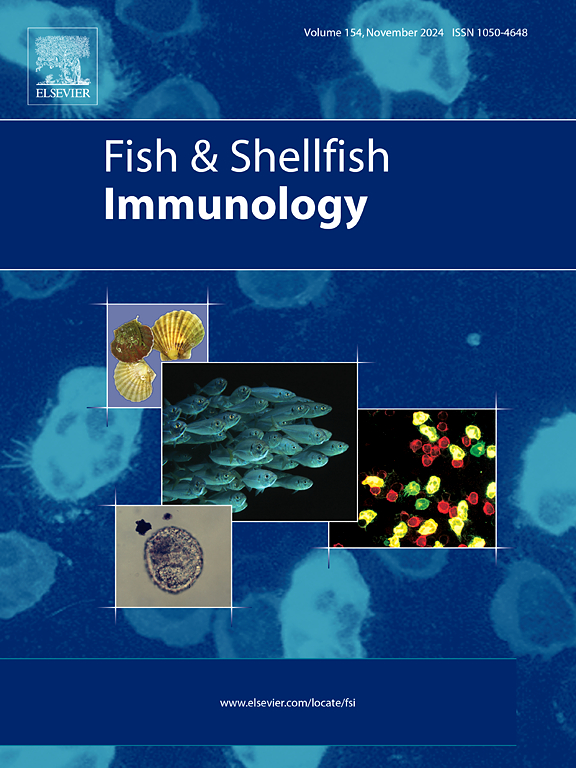Cell-free hemoglobin released from hemolysis induces programmed cell death through iron overload and oxidative stress in grass carp (Ctenopharyngodon idella)
IF 4.1
2区 农林科学
Q1 FISHERIES
引用次数: 0
Abstract
Intravascular hemolysis releases hemoglobin (Hb) from red blood cells under specific conditions, yet the effect of hemolysis in aquaculture systems remain poorly understood. In this study, a continuous hemolysis model for grass carp was established by injection of phenylhydrazine (PHZ) to investigate the mechanistic impacts of sustained hemolysis. PHZ-induced hemolysis altered liver color, and subsequent hematoxylin and eosin staining revealed substantial Hb accumulation in the head kidney, accompanied by inflammatory cell infiltration and vacuolization in liver tissue. Quantitative real-time PCR and western blotting confirmed that PHZ treatment significantly upregulated Real-time fluorescence quantitative PCR and Western blot confirmed that PHZ treatment significantly up-regulated the expression of iron metabolism-related genes and proteins, including transferrin (Tf), ferritin, ferroportin 1 (FPN1), transferrin receptor 1 (TfR1), nuclear receptor coactivator 4 (NCOA4), divalent metal transporter 1 (DMT1), and six-transmembrane epithelial antigen of prostate 3 (STEAP3). Further investigation of PHZ-induced hemolysis effects on tissues showed that inflammation- and antioxidant enzyme–related genes in the liver and head kidney were significantly upregulated, indicating that hemolysis activated the antioxidant system and intensified inflammatory responses. Perls’ staining revealed iron deposition in the head kidney and liver at ten and fourteen days post-PHZ injection. Moreover, β-galactosidase staining and transmission electron microscopy showed increased cellular senescence and mitochondrial damage, respectively, as a result of PHZ-induced hemolysis. In vitro assays with hemin treatment demonstrated increased Fe2+ content in CIK and L8824 cells, which induced oxidative stress, upregulated iron metabolism and inflammatory genes, and ultimately led to cell death. These findings suggest that excessive Hb release during sustained hemolysis leads to iron overload, elevates reactive oxygen species production, disrupts antioxidant balance, and ultimately causes cellular damage.
草鱼(Ctenopharyngodon idella)溶血释放的无细胞血红蛋白通过铁过载和氧化应激诱导程序性细胞死亡。
在特定条件下,血管内溶血从红细胞中释放血红蛋白(Hb),但溶血在水产养殖系统中的作用仍然知之甚少。本研究通过苯基肼(phenylhydrazine, PHZ)注射建立草鱼持续溶血模型,探讨持续溶血的机制影响。phz诱导的溶血改变了肝脏颜色,随后的苏木精和伊红染色显示头部肾脏中大量Hb积聚,并伴有肝组织中的炎症细胞浸润和空泡化。实时荧光定量PCR和western blot证实,PHZ处理显著上调了铁代谢相关基因和蛋白的表达,包括转铁蛋白(Tf)、铁蛋白、铁转运蛋白1 (FPN1)、转铁蛋白受体1 (TfR1)、核受体共激活因子4 (NCOA4)、二价金属转运蛋白1 (DMT1)、前列腺3跨膜上皮抗原(STEAP3)。进一步研究phz诱导的溶血对组织的影响,发现肝脏和头肾中炎症和抗氧化酶相关基因显著上调,表明溶血激活了抗氧化系统,加剧了炎症反应。注射phz后第10天和第14天,Perls染色显示头部肾和肝脏有铁沉积。此外,β-半乳糖苷酶染色和透射电镜分别显示phz诱导的溶血导致细胞衰老和线粒体损伤增加。在体外实验中,hemin处理表明CIK和L8824细胞中Fe2+含量升高,引起氧化应激,铁代谢和炎症基因上调,最终导致细胞死亡。这些发现表明,持续溶血过程中过量的Hb释放会导致铁超载,提高活性氧的产生,破坏抗氧化平衡,最终导致细胞损伤。
本文章由计算机程序翻译,如有差异,请以英文原文为准。
求助全文
约1分钟内获得全文
求助全文
来源期刊

Fish & shellfish immunology
农林科学-海洋与淡水生物学
CiteScore
7.50
自引率
19.10%
发文量
750
审稿时长
68 days
期刊介绍:
Fish and Shellfish Immunology rapidly publishes high-quality, peer-refereed contributions in the expanding fields of fish and shellfish immunology. It presents studies on the basic mechanisms of both the specific and non-specific defense systems, the cells, tissues, and humoral factors involved, their dependence on environmental and intrinsic factors, response to pathogens, response to vaccination, and applied studies on the development of specific vaccines for use in the aquaculture industry.
文献相关原料
公司名称
产品信息
索莱宝
ROS detection probe DCFH-DA
 求助内容:
求助内容: 应助结果提醒方式:
应助结果提醒方式:


